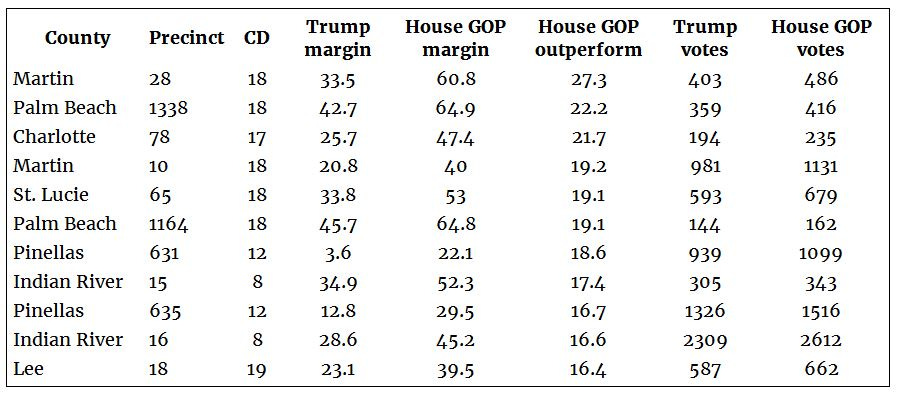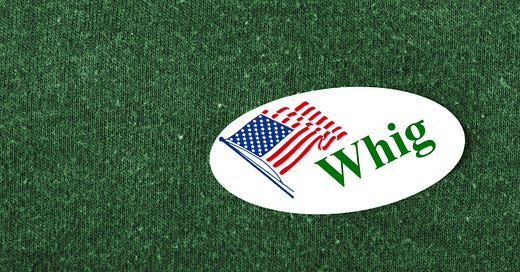To Start a Non-Trumpist Third Party, Think Big by Going Small
Strategic insights from the last time one of America’s two major parties fell.
With Donald Trump’s dominance of the Republican party seemingly unassailable, the conservative critics of Trumpism who opposed his election and re-election are on the hunt for a new political home. Some have argued for creating a new third party while others propose working within the Democratic coalition.
Why not both?
The mustering of a small set of centrist candidates, aligned with a new party that aims not for national scope but for strategically selected electoral victories, would serve the goals of both buttressing a centrist Biden administration and countering the Trumpist Republican party.
Moreover, using the vehicle of a new party would allow candidates, voters, and other supporters to avoid associating with either the Trump brand or the Democratic brand that, because of its association with many lightning-rod progressives, can be a burden for more centrist candidates.
Contrary to popular belief, third parties are not all quixotic enterprises. Many third-party movements in American history have grown to great strength in the electorate. They mostly fizzle out not because third parties are doomed to failure but because one or both of the major parties adopts the popular policies or alignment of the movement. For example, in the 1910s, when the political strength of the Progressive movement was clear, Democrats and Republicans both adopted Progressive party policies and perspectives. Eight decades later, both parties sought in various ways to win over the 19 percent of the electorate that voted for Ross Perot in 1992. Ambitious candidates for office do not long ignore large electoral blocs just sitting for the taking.
Before digging into the details of how such a new, strategically focused party could work, it is worth taking a moment to study what happened the last time one of the two major American parties fell: the Whigs in the 1850s. The Republican party, launched in 1854, did not supplant the Whig party overnight. Well before the Republicans threatened the national hegemony of the Whigs, non-Whig candidates began to succeed in state legislatures and congressional districts amenable to the “free soil” movement—an agglomeration of former Democrats, former Whigs, and abolitionists united in opposing the extension of slavery. The Republican party was not formed until after these initial parties had gained regional success. (For excellent histories of the era, see Tyler Anbinder’s Nativism and Slavery and Eric Foner’s Free Soil, Free Labor, Free Men.)
One clear way of seeing how this transition played out is by looking at party membership in the U.S. House of Representatives in the seven congresses following the 1848 election:

(Via House.gov)
The 1848 election saw the first modest success of what would grow into the Republican coalition, with 9 members from the Free Soil party and 1 American (Know Nothing) against 108 Whigs. (In the proportion of today’s 435-member House, this would equal a new party winning 17 House seats.)
The Whig coalition slowly broke apart in the early 1850s, with the number of Whigs elected dropping to 85 in 1850 and 71 in 1852. The Democrats, as could be expected, increased their seat share during this period as candidates from the splintering Whig party split votes in many districts with candidates from third parties. (A similar dynamic could be anticipated today if a new party were rising.)
In 1854, non-Democratic candidates won a majority of seats and elected a coalition speaker, Nathaniel Banks. Democrats retook the majority in 1856, but that cycle solidified the Republican party as the second major party in the country and ended the Whig party as a national coalition.
By 1858, the Republicans were ascendant and the Democrats again in the minority. And following the 1860 election, the overall number of representatives dropped as several Southern states seceded.
Yes, the rise of the Republican party was a factor in the lead-up to the Civil War. But the success of a third party need not induce conflict. The 1850s saw a more radical party, the Republicans, replace a compromising party, the Whigs. In the scenario being contemplated today, the new party would be more centrist than the GOP whose Trumpification is its reason for being. One would hope this would reduce rather than increase conflict.
There are, of course, many differences in the structure and dynamics of American politics between the 1850s and today. In some ways, it was easier to start a new party back then: The Whig party was only a couple of decades old and was not very deeply entrenched in our political institutions. By contrast, today’s two big parties have the long-term allegiance of generations of voters and are deeply entrenched in our political and media institutions. Both possess huge advantages over third-party challengers.
In other ways, though, it is easier to start a new party today. Phones, databases, airplanes—contemporary technology makes the work of discovering and contacting supporters, organizing, and raising money far easier. The opportunities and technologies mean that a new party need not be a hopeless undertaking and, distant though we are from the 1850s, it is worth seeing what lessons we can draw from that decade of turmoil and transition.
One of the lessons from this history is that third parties need not field candidates in every contest as they build the party. For example, there would likely be little value to the conservative and centrist opposition to Trump in fielding a 2024 presidential candidate; indeed, to the extent that such a candidate would win votes, he or she could be drawing support away from the candidate likeliest to defeat Trump, or whichever Republican carries his torch. But there are many congressional and state legislative races around the country where a centrist candidate could have a reasonable chance of either defeating a Trumpist Republican or of forcing the Republican candidate to appeal to centrist voters with something more than just an attack on “radical, socialist Democrats.”
Put simply, the practical goal of such a new party should be to build an electoral coalition without inadvertently assisting Trumpist Republicans. This requires running candidates only in certain districts. Consider four types of districts. The first two are what I call “no-brainer contests,” in which a candidate from a new centrist conservative party could compete with little risk of benefiting a Trumpist. The second two types, which I call “maybe contests,” require a bit more planning and thought to avoid benefiting a Trumpist Republican.
No-Brainer Contest Type 1. The first type of no-brainer contest is a district without a Democratic challenger to the Republican candidate. Without a Democratic candidate, there is no risk that the centrist candidate will siphon votes away from a non-Trumpist Democrat and inadvertently elect a Trumpist. In 2020, Democrats did not field a candidate in eight House districts: AL-05, AL-06, AR-01, FL-02, FL-25, MS-04, SD-At large, and VA-09. Each of these could be targeted.
No-Brainer Contest Type 2. The second type of no-brainer contest involves races with only one Democrat and one Trumpist Republican in states with specific electoral systems: top-two primary systems (California and Washington for state- and federal-level elections, Nebraska for state-level elections) or majority-runoff systems (Georgia and Louisiana). Both these kinds of electoral systems provide opportunities for third-party candidates to give it a go with lower risk of benefiting a Trumpist. In such electoral systems, the centrist candidate either wins enough votes at the first election to make it into the runoff election or fails to win enough votes at the first election, in which case the contest reverts to the Democrat-Republican contest that would have happened without the centrist entry.
In both these types of no-brainer contests, if the resources and candidates can be found, it makes sense to roll the dice.
The two types of maybe contests, on the other hand, require more strategic consideration.
Maybe Contest Type 1. The first type of maybe contest is a top-two or majority-runoff contest with more than one Democrat and more than one Republican. In such contests, there is some risk that a third-party candidate might split the Democratic vote so that the top two candidates who continue to the second election are two Republicans. In such cases, it might be better for potential third-party candidates to abstain from entry rather than risk harming the cause of opposing Trumpism.
Maybe Contest Type 2. The second type of maybe contest involves races in traditional party primary states where the Republican candidate notably outperformed Trump in 2020. Such outperformance suggests there were many voters in the district who prefer non-Trump Republicans and therefore might be amenable to a centrist. These districts could be an opportunity for a third-party candidate—though again care is required so as not to risk splitting what would otherwise be a Democratic plurality.
Below I provide an example of how to identify districts of this final type. This figure plots overperformance in the 61 districts where (1) Trump won more votes than Biden and (2) the Republican candidate received 3 percentage points or more than Trump. (I drew on data compiled by Daily Kos and the Washington Post. I excluded from the figure 28 districts without both a GOP and Democratic candidate, as well as Louisiana-05, which had a “jungle” primary and runoff.)
For each district, the difference between the vote share received by the Republican candidate and the vote share received by Donald Trump is my measure of overperformance. For example, the greatest overperformance was in Illinois’s 18th congressional district, where incumbent Republican Darin LaHood received 70 percent of the vote against Trump’s 61 percent. The 61 districts shown are a rough set of promising ‘maybe contests’ in party-primary states or no-brainer contests in top-two or majority-runoff states. The closer a district is to the right side of the figure, the more likely it would make a good target for a third party that appeals to voters who lean Republican but vote with skepticism toward Trump. Note that three of the districts with the highest outperforming figures are in states with top-two or majority-runoff systems (WA-04, WA-05, and LA-06).

As some districts are redrawn for 2022, this analysis can be conducted anew by constructing the redrawn districts using 2020 precinct-level election returns. For example, here are the eleven Florida precincts won by Trump in 2020 where the Republican House candidate outperformed at greatest magnitude (data drawn from the Florida secretary of state). Across these eleven precincts, House GOP candidates received 1,201 more votes than did candidate Trump.

One reasonable concern about this strategy involves the possibility that state legislatures dominated by Trumpist Republicans will make these districts less vulnerable through gerrymandering. But state legislators who draw districts to maximize their party’s seat share aim to draw many districts with a modest but not large party advantage. They want to spread around their party’s votes to “waste” as few votes as possible. In states with Republican-controlled legislatures, spreading votes means creating districts with a modest Republican advantage (say 60-40). These are exactly the districts where a centrist candidate has a better shot at either winning the general election or forcing the Republican candidate to tack toward the center.
Another argument one might hear against a third party is that Americans are polarized by and strongly attached to their political parties. Many political scientists make this claim. But there are at least two reasons to be skeptical. First, research on party polarization in the electorate almost always looks only at Americans who identify with the Democratic or Republican parties. That is, it tends to ignore independents and other-party identifiers who make up somewhere between 10 and 33 percent of the electorate, depending on how you measure party attachment. A January 2021 Gallup poll had 50 percent of respondents identify as independents—the highest that figure peaked in the seventeen years of data Gallup published.
Second, partisans are much more polarized in their dislike of the other party than in liking their own. This is sometimes called “negative partisanship,” where the divide is more about negative stereotypes of the other party than positive stereotypes about one’s own. Both facts suggest opportunities for candidates from a new third party.
Confronting Trumpism will require effort on multiple fronts. One is working to support centrist policies proposed by Biden, to increase his coalition’s ability to defeat Trumpist candidates. Another is fielding third-party candidates—strategically targeting districts to maximize the chance of victories. With enough hard work and good candidates, it is not difficult to imagine the election in two years of a few members of Congress, neither Democrats nor Trumpist Republicans, who could constitute a small but important bloc that would serve the public interest.
And if electing a handful of members of Congress seems too modest an achievement to pursue, just remember: Today’s Republican party itself has its roots in the Whig crackup that began with just a handful of new members elected to the House.










